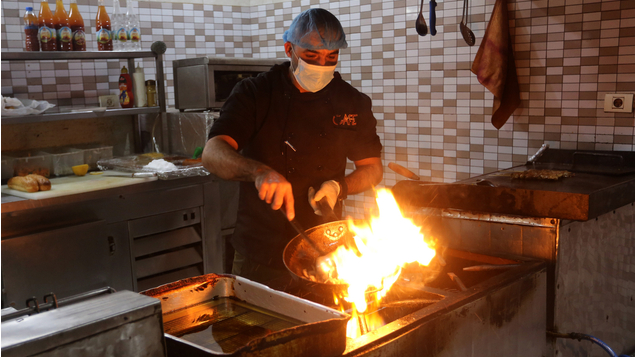[ad_1]

Abed Rahim Khatib / Shutterstock.com
Restaurant staff, factory workers and staff in ‘elementary’ occupations including security guards and taxi drivers were among those who faced a higher risk of dying of Covid-19 in 2020.
Some 7,961 people of working age, ranging from 20 to 64 years old, died of coronavirus in England and Wales between 9 March and 28 December 2020, analysis by the Office for National Statistics found.
It said 31 in every 100,000 working-age men and 17 in every 100,000 working-age women had died of Covid-19. Almost two-thirds (64.4%) of those who died were men.
Men who worked in elementary occupations – such as manufacturing workers or security guards – faced the highest death rates per 100,000 males of the same age than those in other occupations monitored by the ONS, at 66.3 deaths per 100,000.
The death rate was lowest among men in “professional” occupations, at 17.6 Covid-19 deaths per 100,000.
The roles with the highest male Covid-19 death rate were:
- restaurant and catering establishment managers and proprietors (119.3 deaths per 100,000)
- care workers (110 per 100,000)
- metal working and machine operatives (106.1 per 100,000)
- food, drink and tobacco process operatives (103.7 per 100,000)
- chefs (103.1 per 100,000)
- taxi and cab drivers and chauffeurs (101.4 per 100,000)
- nursing auxiliaries and assistants (87.2 per 100,000)
- elementary construction occupations (82.1 per 100,000)
- nurses (79.1 per 100,000).
Women represented 35.6% of the Covid-19 worker deaths in England and Wales. The occupations with the highest female Covid-19 death rate were:
- care workers and home carers (47.1 deaths per 100,000 females)
- assemblers and routine operatives (39.2 per 100,000)
- social workers (32.4 per 100,000)
- national government administrative occupations (27.9 per 100,000)
- sales and retail assistants (26.9 per 100,000)
- managers and directors in retail and wholesale (26.7 per 100,000)
- nursing auxiliaries and assistants (25.3 d per 100,000)
- nurses (24.5 per 100,000).
“These figures demonstrate all too clearly the toll the pandemic has taken, showing in particular that carers, nurses and nursing auxiliaries and assistants, and men who work in healthcare were markedly more likely to die from Covid-19 than the general population between March and December,” Dr Layla McCay, director at the NHS Confederation, said.
“This data shows how important it is to abide by lockdown restrictions while the vaccination programme is being rolled out and that national policy on PPE is adjusted as needed as we gain more evidence around the impact of new strains and whether they pose greater risks.
“This new information makes it clear that the virus can have dire consequences for people of working age, especially for those in roles where interaction with others is greater and risk of exposure is higher.”
Despite the suggestion from teaching unions that teachers faced a higher risk of dying of Covid-19, the ONS found the death rates for this group were statistically significantly lower than Covid-19 related deaths among others of the same sex and age. The death rate for male teachers was 18.4 per 100,000, and 9.8 per 100,000 for females, compared with compared with 31.4 and 16.8 deaths per 100,000 in the population among males and females respectively.
ONS analyst Ben Humberstone said: “As the pandemic has progressed, we have learnt more about the disease and the communities it impacts most. There are a complex combination of factors that influence the risk of death; from your age and your ethnicity, where you live and who you live with, to pre-existing health conditions.
“Our findings do not prove that the rates of death involving Covid-19 are caused by differences in occupational exposure.”
Health and Safety opportunities on Personnel Today
Browse more health and safety jobs
[ad_2]
Source link





